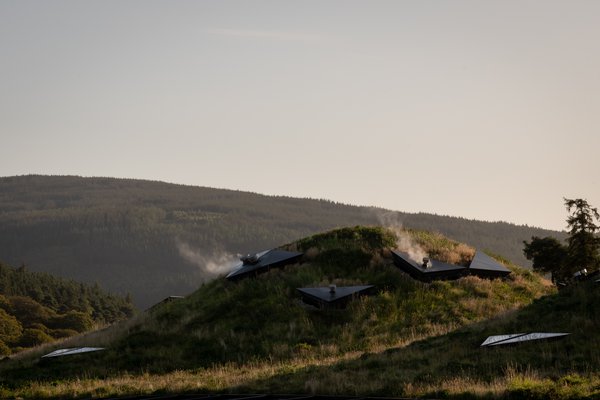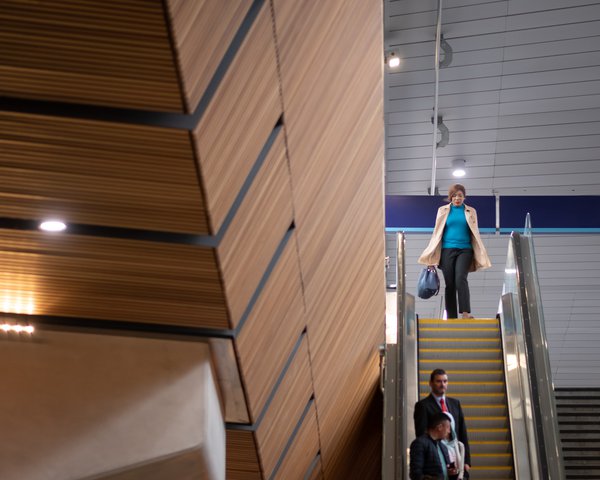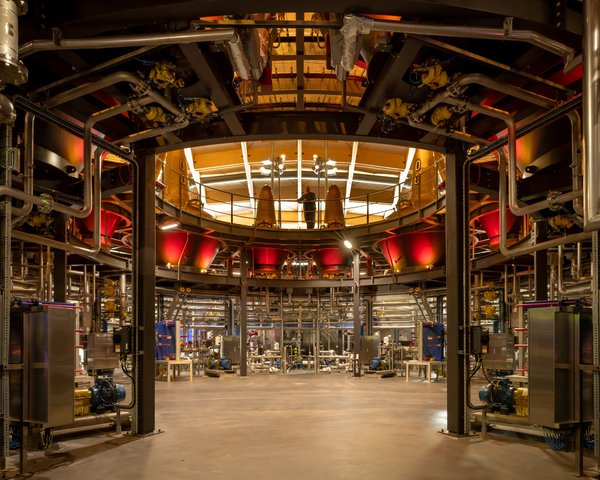The Hidden Sounds of Architecture
Posted: Wednesday, January 29th, 2020
Last year I was commissioned by The Architects’ Journal to make a series of short films about each of the six Stirling Prize nominated buildings. I’d been having a few conversations before that with musician and sound designer, Simon James about the relationship between architecture and sound and so he joined me on the shoots to make a series of recordings, using a range of very specialist recording devices. Whilst our priority was to produce these six mini-docs on the buildings (which you can view here ), the time we had on location also allowed Simon to be a bit more creative with his recordings and editing, creating sparse and evocative soundscapes from on-site recordings which we paired with my footage for two new films; Hidden Sounds…

Jim Stephenson: What first sparked your interest in working with architecture?
Simon James: I’d had some opportunities in the last 10 years to do some projects that were connected with architecture - more with music inspired by architecture really - and I'd always enjoyed it. I enjoyed the crossover of language, and I've got this book by Le Corbusier called Modular. In it, he talks specifically about music and it’s connections to architecture and I found that really interesting.
I became interested in the mid-century stuff that was happening around the world's fairs and the expos where people were pushing the boundaries not just of architecture, but they would often get a composer to create a piece of experimental music to exist in that space and somehow represent the physical in a more ethereal way, to enhance the experience.
So, there's been that interest, and then I've combined that more with field recording and wandering through buildings with non-traditional recording techniques such as contact microphones (which pick up the vibrations in objects rather than vibrations in the air as traditional microphones do), and electromagnetic microphones (which pick up electromagnetic frequencies which we can't normally hear). I think there's something about both those techniques that really appeals to me in a way that I'm always trying to find new things, and I love that moment of discovery where you don't know what to expect.
JS: London Bridge (by Grimshaw Architects) was a really good example for both of those sounds, with the contact mics on the escalators. That deep rumbling, it sounded almost tectonic.
SJ: What those contact mics are so good at is picking up much lower frequencies that we don't hear generally. At London Bridge there were two particular sounds that I was drawn to. One of them is the handrails of the escalator. I always go on about this whenever I talk about London Bridge but it was just completely unexpected. You have a vague idea of what something's going to sound like, but when I connected the contact mics to the left and the right handrails, which was a challenge in itself because you have to stick them to the surface and the escalators are moving so you have limited time, it sounded like a UFO. It's just this weird sort of sound. Those are the moments that I love about working with those sort of non-traditional microphones.

JS: And the electromagnetic microphones, you don’t have to connect to something, you can just have them nearby something?
SJ: Yes, every time there’s an electronic function happening they pick that up. With the ticket barriers at London Bridge, there’s a motor, and that’s what you can hear, the electromagnetic microphone picks up the motor moving as those barriers open and close and what was really lovely is there’s a rhythm to it, you know, when people are coming and going.
SJ: At The Macallan (Visitor Centre and Distillery by Rogers Stirk Harbour + Partners), we were in the Scottish countryside, so we had these amazing natural sounds of the water running from the River Spey, and the birds and the trees, which was beautiful and something that is highlighted in the film at the beginning. But it is an industry there, the production of whisky is industrial, all those sounds that were coming from distillery – it felt like the machine was alive, it felt like it was belching out these sounds, which are quiet if you’re just in the countryside, but get louder when you move inside.
It would be easy to just think “oh well, it’s just noise”, and I think that’s probably something that over the years I’ve got more in tune with. Okay, it starts off being just noise, but when you listen closely there’s a rhythm to it, and there’s different textures, and these noises start to come alive and have a sort of distinct character all to themselves and Macallan was full of that.
There’s these monoliths - I can only imagine they must be chimneys?
JS: Yes, I think they’re big vents for the stills.
SJ: I spent about an hour recording them – just a contact mic stuck to one of them. Initially it was because I’d heard it belch, but I wasn't near it then. Although it never ‘beltched’ whilst I was connected what I did get was more like tuning into the heart of the building. There's obviously stuff going on in the distance that's happening as part of the process of whiskey making, and it feels like you're really tuning into it.

JS: I suppose a contact mic is almost like having a stethoscope?
SJ: Yeah, you’re right. It really is.
JS: When you go into buildings you must just be constantly alert to the sounds around you, even if you’re not there specifically to record it.
SJ: Yes, definitely. It’s funny, things catch my eye probably more than they do my ear now because I’m looking for objects that might be interesting to attach a contact mic to. So, I’m looking at things and going oh, I wonder how resonant that is, or what would happen if I run a beater or some scraper over that, what’s it going to sound like?
In fact, in my local shop there’s a really good fridge that I keep meaning to record. I really should record it but never get around to it. They'll probably throw me out if I took my microphones in there!

JS: You’re not just using contact mics and electromagnetic mics though. How are you recording the ambient sound that we can actually hear?
SJ: I use a really simple setup, and actually people often look at it and laugh. I use a stereo spaced pair of Omni microphones attached to a coat hanger.
JS: That’s just to get space between them?
SJ: Yes. Basically I copied this technique from Chris Watson who's a well-known sound recordist. I don't know if he uses it now so much, it’s sort of a bit of a legendary or mythical kind of thing where everyone talks about the Chris Watson coat hanger thing. It’s really versatile and so, I enjoy using that. The thing about Omni mics is that they've got a particular pattern that picks up from all around rather than a more directional microphone, so they're really well suited for recording spaces and ambiance. They also go down to a much lower frequency, so they're much closer to the human ear which means that when you record with them I think they're much easier to connect with as a listener.
What I really love about them is that you can get them into places that you can't get other mics. At Walmer Yard (London, by Peter Salter, Fenella Collingridge and Mole) I was able to attach them to things like the bottoms of doors, and then I moved the doors to get this amazing sound (you can listen to Simon's Walmer Yard piece here).
I just have all this equipment that works for me and allows me to capture the things I need to make my work.

Simon has created a fascinating album that contains both the soundscapes from the films in this post, and also a series of recording of different parts of both buildings (including the handrails and ticket gates at London Bridge and the vents at The Macallan, that he mentions in the interview). You can listen to it here, and support his work by paying for a copy as well...
HIDDEN SOUNDS by Simon James


